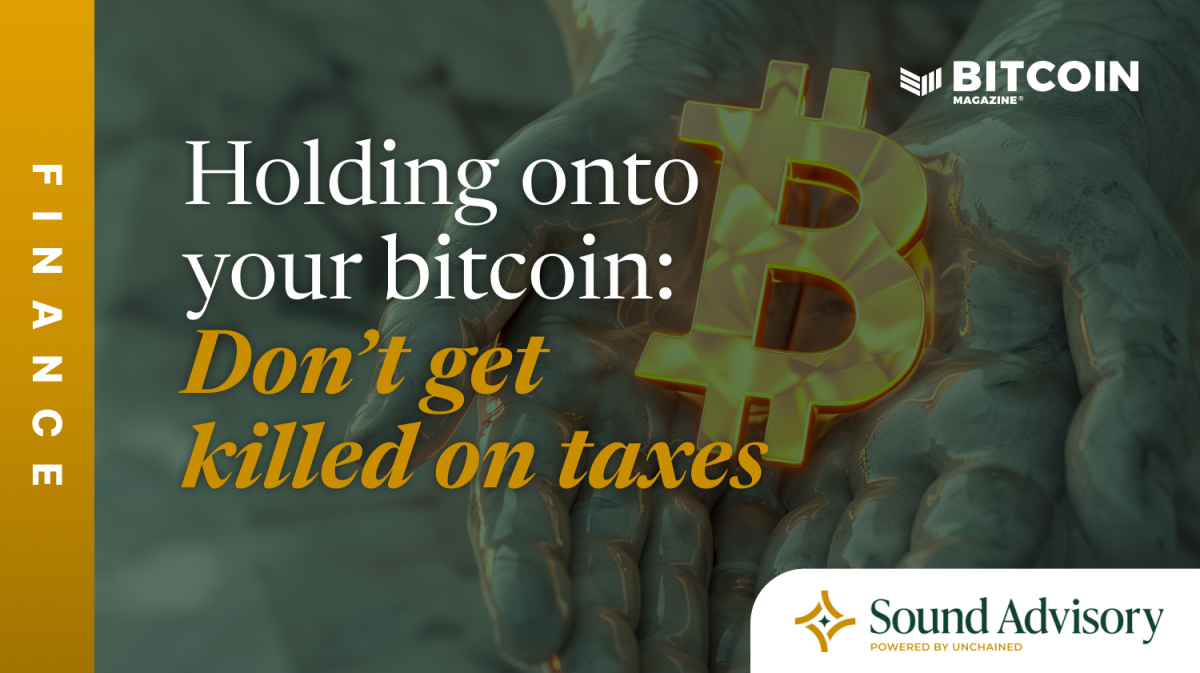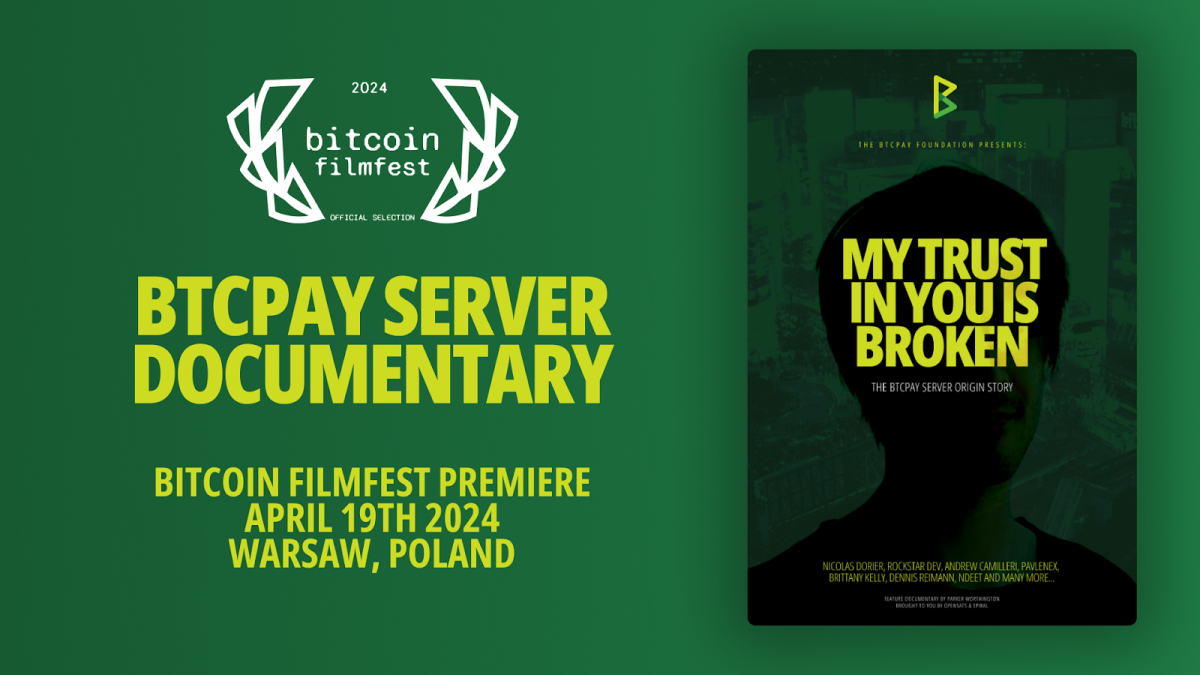Month: April 2024
Japanese yen intervention threats continue as USDJPY tests 153
Post Content
Holding Onto Your Bitcoin: Don’t Get Killed On Taxes
This article originally appeared in the Sound Advisory blog. Sound Advisory provides financial advisory services and specializes in educating and guiding clients to thrive financially in a bitcoin-powered world. Click here to learn more.
One of the simplest and most effective ways to improve your financial situation: Don’t get killed on taxes.
Taxes are a major friction in most people’s financial lives, and a little foresight and planning can go a long way. This article will cover a few helpful tips and case studies that could help you improve your future tax planning.
Let’s touch on a quick refresher. Keep these two foundational concepts in mind as you consider possible strategies.
Cost basis: Keep detailed records of all your bitcoin transactions
Maintaining meticulous records of every bitcoin transaction and its associated cost basis is not just a good practice but a crucial one, given the Internal Revenue Service’s (IRS) authority to audit returns up to six years back.
The answer is yes if you’re wondering whether the IRS can track bitcoin transactions. The IRS employs various means to monitor bitcoin activities. Here’s how:
KYC Compliance: All major cryptocurrency exchanges must conduct Know Your Customer (KYC) checks, ensuring that your identity is tied to your holdings.Transaction History: Many exchanges keep detailed records of the addresses associated with your withdrawals. This enables them to identify custodial wallets and track additional downstream transactions.Reporting to IRS: Numerous exchanges must submit 1099 forms to users and the IRS, providing a comprehensive overview of taxable events and gains.Legal Precedents: The IRS has successfully litigated cases against prominent exchanges such as Coinbase, Kraken, and Poloniex, compelling them to disclose customer data. This legal standing solidifies the IRS’s ability to access crucial information about bitcoin holdings and transactions.
Given these measures, it is essential to recognize that the IRS is well-informed about bitcoin activities. Consequently, it is prudent to strategize your bitcoin tax plan accordingly.
Many individuals venture into bitcoin investments without fully grasping the potential tax implications. Buying, selling, trading alternative coins, and switching exchanges may seem routine, but each event carries distinct tax implications. Neglecting these consequences can result in a complex situation during tax season.
To navigate the intricacies of bitcoin taxation, it is imperative to establish and comprehend your cost basis. Taking the time to go back and organize your past transactions and maintaining clear, systematic records moving forward can streamline the tax reporting process, saving you time and mitigating potential issues. If you find the landscape of bitcoin taxes overwhelming, seeking guidance from a tax professional is a wise step to ensure that you are well-prepared and in compliance with tax obligations related to your bitcoin investments.
Tax tables: Not all bitcoin is taxed the same
The IRS treats bitcoin as property, not money, so it is subject to capital gains tax (not ordinary income tax) when sold, traded, or spent. Capital gains are taxed under two possible taxation tables: short-term and long-term capital gains.
The following table helps visualize: Short-term gains on bitcoin held one year or less are taxed as ordinary income rates (green column). Refer to the yellow column if bitcoin is held for more than a year.
Source: Sound Advisory
If you hold bitcoin for over a year before disposing of it, you will pay long-term capital gains tax, which ranges from 0% to 20%, depending on your income.
Furthermore, these tables only apply to non-qualified bitcoin—bitcoin not held in a retirement account. Qualified distributions from Traditional IRA bitcoin are always taxed as ordinary income (green), and Roth IRA distributions can be tax-free.
With that as a backdrop, let’s get into some potential strategies that many bitcoiners often overlook.
Strategies and Case Studies
Bitcoin tax can snowball: Evaluate your cost-basis strategy
Purchasing bitcoin is like freshly fallen snow – pure and untouched. It isn’t taxable. But you incur a taxable event when you set foot in that snow with a sell, trade, or spend. And similar to how a snowball grows as you roll it down a hill, the tax implications of your bitcoin transactions can accumulate over time.
When accounting for transactions, it’s important to remember that each event will impact your cost basis.
The IRS allows for “specific identification” accounting for bitcoin, where you keep track of every inventory item—in this case, every chunk of bitcoin. Specific identification has variations like FIFO (first-in, first-out), LIFO (last-in, first-out), and HIFO (highest-in, first-out) when matching dispositions (sells, trades, spends) with acquisitions (buys, income). With a good identification record, you can run projections to see which method gives you the lowest gains.
Scenario: Adam bought 1 BTC in January 2023 for $16,000 and another 2 BTC in March 2023 for $48,000. He sold 1 BTC in August 2023, when 1 BTC is worth $30,000.
With FIFO, Adam has a $14,000 capital gain (sale price of $30,000 less cost basis of $16,000).With LIFO, Adam has a $6,000 capital gain (sale price of $30,000 less cost basis of $24,000).HIFO is the same as LIFO in this case.
These would be short-term capital gains, so let’s assume a hypothetical 22% federal tax rate. Adam can pay $1,760 less tax by choosing LIFO over FIFO.
It’s quite simple when there are only a few transactions, but it can easily become complicated with every additional buy, sell, or spend. Cost basis and the subsequent transaction matching is an evolving calculation that could have drastic consequences if done incorrectly.
Tax loss harvesting
Recently, bitcoin has been trading near its all-time highs. So, this strategy is less relevant, but we’ll leave it here for future readers.
In a tax loss harvesting strategy, you can sell at a loss to offset other income or capital gains and lower your tax liability. If you have realized capital gains from selling bitcoin this year, look at coins you’re still holding that are trading below their purchase price.
Scenario: Hal has a $15,000 short-term gain from selling a stock before holding onto it for a year. In December, he decides to sell some bitcoin at a $12,000 loss. This offsets $12,000 of his stock gain, so he only needs to pay capital gains tax on the remaining $3,000 gain instead of $15,000. At a 22% tax rate, $2,640 is saved.
Just because you had a loss this year doesn’t mean you necessarily want to use that loss this year. You can look at using the tax loss carry forward technique. Up to $3,000 in annual losses can offset your other income (things like wages, rental income, etc.). However, any amount over $3,000 must be carried forward to be used in future years. Some strategic clients may decide to harvest and report losses now so you can reduce taxes and carry them forward to offset future gains.
If attempting to harvest losses, please be aware of the wash sale rule, described in further detail at the end of this article.
Tax gain harvesting: The 0% tax bracket
A peculiar tax rate in the capital gains table above is 0.00% tax on long-term capital gains.
For 2024, if total taxable income falls under $94,050 as a married couple ($47,025 single), you can sell long-term capital assets, and gains are taxed at 0% federally. Paying a 0% tax ain’t so bad. Sign me up. I’ll even pay it twice.
And “taxable income” is calculated after the standard deduction, which adds another $29,200 for married ($14,600 single).
Scenario: Let’s assume Stacey and Max are married with $100,000 combined in W2 income from their jobs at the embassy. They sell some bitcoin throughout the year and realize a $16,000 long-term capital gain. Some quick math: $100,000 (W2) plus $16,000 (cap gain) is $116,000. Take out the standard deduction of $29,200, and the taxable income is $86,800. Since their total taxable income for the year is below the $94,050 threshold, their bitcoin gains are taxed at 0% (tax-free). And we’ll assume that they live in one of the nine US states that don’t have an income tax, so let’s call it 0% state tax as well.
It is possible to sell non-retirement bitcoin tax-free—valuable information for those looking to sell. If you are in a situation where you think these income levels/brackets may apply to you (now or in the future), a strategic sell and immediate rebuy opportunity awaits: the tax gain harvest.
Sometimes, it makes sense to sell bitcoin, recognize a gain at 0% rates, and immediately buy it right back. By repurchasing the bitcoin immediately, you effectively set a new cost basis for your investment. This new basis is higher than your original purchase price. In the future, if bitcoin’s value continues to rise and you decide to sell again, you’ll be taxed on a smaller gain, thanks to the earlier gains harvesting.
Gains harvesting is: sell your bitcoin, take advantage of the 0% bracket, and buy it right back (wash sale rules only disallow losses – not gains).
The desired outcome here is an increase in tax basis. In the future, you’ll be taxed on a smaller future gain, thanks to the earlier gains harvesting.
A prime opportunity for gains harvesting often comes during retirement. When people stop working, they typically stop receiving income from their jobs (say goodbye to those W2s!). This significant drop in income could place them in that coveted 0% tax bracket. With that extra room, they can maximize their tax strategies not just with gains harvesting but also with other income structuring strategies Roth IRA conversions or liquidating assets through installment sales.
Gifting
We’ll cover three target gift recipients: charitable organizations, donor-advised funds, and other people.
Charity
When you donate bitcoin to a qualifying charitable organization, you can deduct the full fair market value of the donation. This will allow you to avoid paying capital gains tax on the appreciation before gifting yet still get the write-off. Donating bitcoin directly rather than cash proceeds from selling it is more advantageous, as the latter would trigger capital gains tax. Just remember to obtain a receipt from the charity for your records and get a special valuation assessment if needed.
Scenario: Jack bought 1 bitcoin in 2015 for $200. It’s now worth $70,000. He donated 0.25 BTC to a charity this December and got a receipt showing its value of $17,500. Jack claims a $17,500 charitable deduction. If he had sold the bitcoin and given cash instead, he’d pay tax on $17,450 in capital gains.
You can effectively give more value by gifting rather than selling and giving cash.
“But I don’t want to have less bitcoin!”
If bitcoin holders are familiar with “spend and replace,” we can consider a similar strategy like “donate and replace.” You can gift appreciated bitcoin and repurchase with cash to increase the cost basis (like the above example – gains harvesting), thus lowering future taxes.
Donor-advised funds
For regular or substantial contributors to charitable causes, a donor-advised fund (DAF) presents a mechanism for amplifying their philanthropy. Think of a DAF as a “charitable savings account”: You make contributions with assets, secure an immediate tax benefit, and then, at your discretion, advise on investing those assets and distributing the grants to charities of your choice over time.
Incorporating bitcoin into this structure introduces an exciting dynamic. Given its potential for significant appreciation, designating it as an asset within a DAF can exponentially magnify the fund’s growth potential. The result? A larger reservoir of resources dedicated to driving positive change in the world, all while efficiently navigating tax implications.
Friends and family
Giving bitcoin to others transfers the original tax basis and gets bitcoin out of the estate.
Instead of selling bitcoin and realizing gains, you can gift bitcoin up to the annual gift exclusion amount of $18,000 per person per recipient. The gift tax annual exclusion is the amount you may give each year to individuals and certain types of trusts tax-free without using any of your gift and estate tax exemption. As the giver, you do not owe taxes on gifts under the exclusion amount of $18,000. The recipient inherits your cost basis and will owe capital gains when they eventually sell (perhaps at a lower bracket/rate than you).
Scenario: A married couple, the Nakamotos, want to give a significant amount of bitcoin to their daughter Kristina and her new husband. Annual exclusion amounts are $18,000 per person. Effectively, the Nakamotos can gift $72,000 without dipping into their “lifetime bucket.” Dad to Kristina. Dad to husband. Mom to Kristina. Mom to husband. $18,000 each.
Roth accounts
Using a Roth IRA can eliminate ALL future tax liability.
If eligible, contributing to a Roth IRA or 401k allows for tax-free appreciation and distribution if held to age 59.5. Since Roth accounts provide tax-free growth, they are ideal for long-term bitcoin holdings.
If you own bitcoin outside an IRA that you want to hold long term, you could sell the bitcoin, contribute the USD proceeds to the Roth IRA, and repurchase the bitcoin inside the Roth. This eliminates the bitcoin cost-basis tracking requirement and allows future appreciation to be tax-free upon qualified distribution.
Conclusion
The maximum contribution to an IRA in 2024 is $7,000 per person ($8,000 if over 50), and you have until April 2025 to make 2024 contributions. Consult your financial or tax advisor to see if this strategy suits you.
With proper tax planning, bitcoin investors can maximize after-tax returns and minimize tax liability. Work closely with your tax professional to implement the right strategies based on your situation. Keep meticulous records and understand the nuances around cost basis, tax loss harvesting, retirement accounts, charitable gifting, and other techniques. The bitcoin tax rules can be complex, but the long-term rewards of proper planning are well worth the effort.
A note on wash sales
The wash sale rule prevents claiming a capital loss if you repurchase the same security within 30 days before or after the sale. This rule currently applies only to securities, not commodities like bitcoin.
Some bitcoin investors have taken advantage of this loophole by selling at a loss and immediately repurchasing while claiming the capital loss to reduce their tax liability. This tax loss harvesting strategy is extremely risky and not recommended.
Even though wash sales are not explicitly prohibited for bitcoin yet, the IRS could determine this pattern violates the essence of wash sale rules under the step transaction doctrine. Engaging in systematic wash sales to harvest losses could trigger penalties and interest if identified in an audit.
It is safer to avoid wash sales of bitcoin, even though technically allowed now. Do not sell at a loss and reacquire the same bitcoin within 30 days before or after the sale. Consult a qualified tax advisor before attempting any tax strategies involving cryptocurrency.
1) Transferring bitcoin between your wallets is not taxable. Only transfers between separate parties are taxable events.
2) These rates only affect federal taxation. Capital gains are taxed in varying ways and rates at the state level. Please consult your tax professional regarding state taxation, as it may change the appropriate strategies and recommendations for your situation.
CONTACT
Office: (208)-254-0142
408 South Eagle Rd.
Ste. 205
Eagle, ID 83616
hello@thesoundadvisory.com
Check the background of your financial professional on FINRA’s BrokerCheck. The content is developed from sources believed to be providing accurate information. The information in this material is not intended as tax or legal advice. Please consult legal or tax professionals for specific information regarding your individual situation. Some of this material was developed and produced by FMG Suite to provide information on a topic that may be of interest. FMG Suite is not affiliated with the named representative, broker – dealer, state – or SEC – registered investment advisory firm. The opinions expressed and material provided are for general information, and should not be considered a solicitation for the purchase or sale of any security.
We take protecting your data and privacy very seriously. As of January 1, 2020 the California Consumer Privacy Act (CCPA) suggests the following link as an extra measure to safeguard your data: Do not sell my personal information.
Copyright 2024 FMG Suite.
Sound Advisory, LLC (“SA”) is a registered investment advisor offering advisory services in the State of Idaho and in other jurisdictions where exempt. Registration does not imply a certain level of skill or training. The information on this site is not intended as tax, accounting, or legal advice, as an offer or solicitation of an offer to buy or sell, or as an endorsement of any company, security, fund, or other securities or non-securities offering. This information should not be relied upon as the sole factor in an investment-making decision. Past performance is no indication of future results. Investment in securities involves significant risk and has the potential for partial or complete loss of funds invested. It should not be assumed that any recommendations made will be profitable or equal any performance noted on this site.
The information on this site is provided “AS IS” and without warranties of any kind, either express or implied. To the fullest extent permissible pursuant to applicable laws, Sound Advisory LLC disclaims all warranties, express or implied, including, but not limited to, implied warranties of merchantability, non-infringement, and suitability for a particular purpose.SA does not warrant that the information on this site will be free from error. Your use of the information is at your sole risk. Under no circumstances shall SA be liable for any direct, indirect, special or consequential damages that result from the use of, or the inability to use, the information provided on this site, even if SA or an SA authorized representative has been advised of the possibility of such damages. Information contained on this site should not be considered a solicitation to buy, an offer to sell, or a recommendation of any security in any jurisdiction where such offer, solicitation, or recommendation would be unlawful or unauthorized.
Crypto Wallet Maker Keystone Debuts Bitcoin-Only Firmware for Flagship Device
Crypto wallet company Keystone recently released bitcoin-only firmware for its most advanced device, the Keystone 3 Pro.
It is here! 📢 The #Bitcoin only firmware release for Keystone 3 Pro is now Available.
New Features including:
-Blue, Sparrow, Nunchuk support
-Taproot support through Sparrow
-XPUB QR code Display
-Bitcoin Testnet support
-Passphrase support
-Shamir Backup support#BITCOIN… pic.twitter.com/KHk5Ia0SdB
— Keystone Hardware Wallet丨Bitcoin-Only (@KeystoneForBTC) April 2, 2024
Keystone, which rebranded from Cobo Vault in June 2021, has been producing crypto wallets since February 2018. The company first launched a bitcoin-only firmware in 2020 and has now released an overhauled version of the firmware after taking into consideration feedback from its customers.
“Since day one, we have been listening closely to the Bitcoin community, trying our best to develop the most secure hardware wallet,” Keystone CEO Lixin Liu told Bitcoin Magazine.
“Upon receiving feedback from the community, we rewrote our embedded system using Rust, often considered the least prone to bugs, and open sourced every line of the code, allowing users to scrutinize and verify the firmware integrity anytime,” he added.
The new firmware also supports security-oriented features like Shamir Backup implementation and the import of three different seed phrases.
And not only is the new firmware more secure, but the Keystone 3 Pro itself was also designed with security in mind. The device is air-gapped, contains three Secure Element chips and comes with a built-in self-destruct mechanism that erases all stored private keys if it detects physical tampering. It also enables users to create a seed phrase without having to pair it with any native software first, eliminating the potential risk of the private key being extracted through the software.
“In addition to security upgrades, we’ve focused on improving usability,” Liu told Bitcoin Magazine.
Liu highlighted how the firmware seamlessly operates with Blue Wallet, Sparrow Wallet, and Nunchuck as well as how the Keystone 3 Pro has a 4-inch color touchscreen and a fingerprint scanner, which makes signing into the device more convenient. He also shared that the battery life for the device is over 20 times greater than that of its predecessor.
The Keystone 3 Pro is currently retailing for $129 on the company’s website, Amazon, and Newegg.
“We’ve kept our product affordable without compromising product quality, UX, and security,” Liu added.
You can learn more about the Keystone 3 Pro here and download the bitcoin-only firmware for the device here.
US dollar surges to new 34-year high vs yen after hotter-than-expected inflation data
Post Content
How Does a Bitcoin Loan Work?
Bitcoin has shown itself among the best-performing assets in the last decade. In 2023, it outperformed the S&P 500, high-yield corporate bonds, and gold, soaring as much as 156 percent in a year.
Today, Bitcoin demand is reaching record highs as the approval of new spot Bitcoin ETFs has created a wave of institutional interest.
Although dubbed a risky and volatile asset, Bitcoin remains a profitable investment, especially for its earliest investors. When it was launched in 2009, it was practically worthless. In 2010, it traded at $0.10.
By 2013, it was hitting highs of $250—a 250,000 percent growth for early investors. Those who invested in 2017 would look at gains of over 6,700 percent in 2024 as the crypto asset briefly touched $70,000 recently.
With this kind of growth, it’s no wonder that investors view it as a long-term investment, preferring to “HODL” until it reaches new price highs.
However, any long-term BTC holder knows the path toward profitability isn’t always smooth sailing. Sometimes, you need to sell or take profits to sustain expenses or meet emergency cash needs.
As a result, you surrender part of your BTC holdings and reduce its long-term earning potential. Those intent on replenishing their Bitcoin also end up re-purchasing the asset at many times the price of the original buy.
What if there were another way to gain access to much-needed funds without selling your BTC? Bitcoin loans offer a solution that provides access to liquidity without letting go of your holdings.
How does a Bitcoin loan work? Here, we delve into the unique mechanics of a Bitcoin loan. We discuss how the world’s leading cryptocurrency is revolutionizing the world of finance beyond trading by providing alternative means to secure loans while retaining access to potentially higher returns in the future.
Click the image to learn more.
Understanding Bitcoin and Crypto Lending
Bitcoin loans are a form of crypto lending. Crypto lending platforms allow BTC investors to borrow against their deposited assets. They can also lend out their BTC holdings to earn interest in crypto rewards. In 2020, crypto lending platforms began gaining significant traction. They have since expanded to hold billions in total value locked (TVL) across several platforms.
You can divide crypto lending into two components. Crypto or BTC deposits that earn interest and crypto loans. Deposit accounts on such platforms behave like regular bank accounts. You can deposit BTC and earn interest. The platform can use the deposited funds to lend to borrowers or for other investments—similar to how a bank operates.
Typically, crypto loans are offered as collateralized lending products. They require users to deposit a 100 percent minimum to access the loan. Some require up to 150 percent—thus becoming overcollateralized loans.
How To Secure a Bitcoin Loan
A Bitcoin or Bitcoin-backed loan is a US dollar loan that BTC collateralizes. To secure this type of loan, you send BTC to a lending platform as collateral. In return, you receive a loan in stablecoin or US dollars.
The mechanics of Bitcoin-backed loans are similar to traditional secured loans, except BTC is the collateral. Such loans eliminate the need for extensive credit checks. The steps include account creation, brief onboarding, key upload, and loan application submission. In decentralized platforms, the process could be even more straightforward.
Once your BTC deposit is confirmed on the blockchain, US dollars or an equivalent in stablecoin is sent to your bank account or crypto wallet. The interest on the loan is paid in regular intervals. For example, interest payments could be due every 30 days and will go on until the loan matures. The final interest payment and the principal amount will be due upon maturity.
The amount you receive is based on the value of your BTC holdings and the platform’s LTV (loan-to-value) ratio. The LTV ratio is determined based on risk factors associated with the crypto market’s volatility. Should the value of Bitcoin drop, the platform may require you to add more collateral to equalize the borrowed amount. If you don’t add collateral, you risk liquidating your BTC holdings.
Factors To Consider When Applying for a Bitcoin-backed Loan
Bitcoin loans are not risk-free. While they offer many benefits, consider the following before deciding to lend out your BTC holdings:
Risks associated with rehypothecation
Some Bitcoin lenders mimic the processes of banks, which means your deposited BTC may be subject to rehypothecation. Rehypothecation is the process of lending out client assets posted as collateral.
Thus, the BTC is put at risk. The lending platform, in turn, earns interest by utilizing your digital assets for various purposes, including re-lending. Some Bitcoin-backed loan providers lend clients’ Bitcoin to third parties.
With rehypothecation, the loan provider earns interest from both the borrower’s interest payments and the proceeds of lending the BTC collateral to other parties. The lender passes a portion of the interest to the borrower of US dollars through a marginally lower interest rate. However, some of the borrower’s collateral—or even 100 percent—is at risk.
Borrowers are unaware of the counterparty risk surrounding BTC-backed loans. Their holdings are exposed to multiple layers of counterparty risk. Lenders who rehypothecated collateral, therefore, expose borrowers to risk when either party becomes insolvent.
Thankfully, some BTC loan providers do not rehypothecate. It is up to the user or client to select the features of a lending platform and decide how much risk they can take on.
Annual percentage rate (APR)
The annual percentage rate, also known as the APR, is the yearly interest rate generated by a sum charged to borrowers or paid to investors. The APR is a percentage representing the annual cost of funds over a loan term or an investment’s earned income.
In other words, it annualizes the total cost of a loan. The value includes additional costs or fees associated with the transaction. APR does not factor in compounding.
The APR provides platform users a bottom-line number to compare investment products and lenders. Some lending companies offer low interest rates but charge high origination fees. This feature will cause the APR to increase significantly. A higher APR means it is more expensive for the borrower when multiple loans originate in a single year.
A short-term loan will promise low interest rates. However, you need to check the origination fee. It will be cheaper to take out a twelve-month loan at a slightly higher interest rate with a one-time origination fee than getting a three-month loan with a 1 percent origination fee and renewing it.
LTV requirement
The LTV or loan-to-value requirement must be considered when you take out a Bitcoin-backed loan. For example, a 40 percent LTV means a $10,000 loan will require $25,000 worth of BTC as collateral. The ratio aims to prevent collateral liquidations as the market price fluctuates.
Some lenders offer low interest rates and lower LTV ratios. A lower LTV ratio could range from 20 to 30 percent. Therefore, the clients must deposit more BTC to access the loan. This practice is done to have the ability to lend out or rehypothecate the collateral to others. Another reason for a low LTV is that higher collateral means less risk when they lend.
Collateral to principal (CTP) vs. loan to value (LTV)
The CTP, or collateral-to-principal ratio, is the LTV’s inverse value. For example, an LTV at 40 percent equates to a CTP of 250 percent. CTP helps users understand the current status of their collateral ratio. This value is instrumental when the BTC price drops.
Tax implications
Tax legislation around Bitcoin loans is still evolving. It is crucial to consult a tax professional about your possible tax obligations, even if it is reasonable to expect BTC-backed loans to be treated analogously to traditional lending practices by the IRS.
The IRS declared in 2014 that virtual currencies be treated as property when it comes to tax treatment.
Therefore, they trigger capital gains taxes when sold. Borrowing against Bitcoin or crypto, however, would not trigger those taxes.
Nonetheless, consulting a tax expert regarding current and future tax issues with Bitcoin loans is best.
Click the image to get $100 off Unchained IRA.
What are the benefits of Bitcoin loans?
Bitcoin-backed loans offer several advantages, especially for long-term holders. The most obvious benefit is access to liquidity without the need to sell off BTC holdings. Bitcoin loans preserve your digital asset holdings. They also save you capital gains tax as a result of not selling.
Photo by Dmytro Demidko on Unsplash
Moreover, BTC loans tend to offer a higher level of privacy versus those from traditional financial institutions. They don’t typically require extensive credit checks and disclosure of extensive personal information. To secure a Bitcoin loan, you will only disclose minimal information for identity verification.
Another benefit of Bitcoin loans is speed. Some Bitcoin-collateralized loans can be obtained within days, hours, or even minutes.
Bitcoin Loans: An Alternative To Selling Your Bitcoin
Owning Bitcoin offers many advantages, including generating significant growth in your investment and having a scarce asset that doubles as a decentralized mode of payment.
Hence, holders understandably think twice about selling BTC to fund urgent expenses in US dollars. However, we all need to take care of our financial needs.
Bitcoin-backed loans bridge the gap between owning a profitable investment with high growth potential and temporarily meeting fiat-based expenses. Several platforms offer Bitcoin-backed loans with varying features and requirements. You must evaluate the pros and cons of each platform and use the ones that balance risk with the most significant financial benefits.
As you hold your Bitcoin long-term, you can explore novel products and services that protect your wealth as they offer an avenue to meet financial needs, invest in other assets, and take advantage of business opportunities.
This is a guest post by Ivan Serrano. Opinions expressed are entirely their own and do not necessarily reflect those of BTC Inc or Bitcoin Magazine.
Bitcoin Payment Processor BTCPay Server To Debut Origin Story Documentary In Poland
BTCPay Server, an open-source bitcoin payment processor, is set to premiere a feature documentary titled “My Trust In You Is Broken” at the Bitcoin Film Fest in Warsaw, Poland, on April 19.
The documentary, directed by Parker Worthington, delves into the beginnings of Bitcoin as a payment system and highlights Nicolas Dorier’s inspiring story in founding and building BTCPay Server.
MY TRUST IN YOU IS BROKEN@BTCPayServer documentary premieres at @bitcoinfilmfest on April 19th, 2024 at 6:30 PM!
Don’t miss out on witnessing the journey of our project rising from the Blocksize Wars ashes. See you in Warsaw! #MYTRUSTINYOUISBROKEN pic.twitter.com/N7l2GI6ktE
— BTCPay Server (@BtcpayServer) April 4, 2024
The story of “My Trust In You Is Broken” revolves around the Block Size Wars era in 2017, particularly BitPay’s advocacy for SegWit2x, which would have increased Bitcoin’s block size limit. Seeing this, Dorier was motivated to create BTCPay Server in defiance of this centralized control, empowering merchants to accept Bitcoin directly on their own, promoting decentralization and independence from intermediaries.
The documentary, spanning 42 minutes, sheds light on the importance of verifying transactions and the risks associated with trusting third parties blindly. It showcases BTCPay Server’s journey from its inception in 2017, highlighting its evolution into a community-driven platform known for its privacy and autonomy features.
The film, which began production at the Bitcoin 2023 Conference in Miami, captures key moments and interviews with BTCPay contributors, providing a comprehensive perspective on Bitcoin’s development as a medium of exchange. “My Trust In You Is Broken” aims to serve as a testament to the ongoing evolution of Bitcoin and the importance of community-driven initiatives like BTCPay Server in shaping its future.
This is lies, my trust in you is broken, I will make you obsolete
— Nicolas Dorier (@NicolasDorier) August 18, 2017
More information on the Bitcoin Film Fest can be found on its website here.
$200 Billion: US Bitcoin Spot ETFs Top $200 Billion in Trading Volume
U.S. spot bitcoin exchange-traded funds (ETFs) have surpassed $200 billion in cumulative trading volume since launching just three months ago.
JUST IN: 🇺🇸 US #Bitcoin spot ETFs trading volume surpasses $200 billion within just 3 months.
Asia is next 🚀 pic.twitter.com/VxQdQJEIjN
— Bitcoin Magazine (@BitcoinMagazine) April 10, 2024
According to data from The Block, the total volume for the SEC-approved funds crossed the $200 billion milestone on Tuesday. This comes after spot bitcoin ETFs saw a record monthly volume of $111 billion in March, triple that of February.
The ETFs debuted on January 11th when bitcoin traded around $45,000. Since then, bitcoin has climbed to an all-time high above $73,000, buoying interest and trading activity.
BlackRock’s IBIT leads the volumes, which now hold over 265,000 bitcoins worth more than $18 billion. IBIT comprises nearly 50% of the total spot ETF volume. Meanwhile, Grayscale’s GBTC and Fidelity’s FBTC rank second and third in market share.
The success of U.S. spot bitcoin ETFs has prompted applications in other markets like Hong Kong. Regulators there are expected to approve the first spot bitcoin ETFs in Asia this month, potentially adding more volume.
ETF providers cite surging institutional demand for regulated Bitcoin exposure. The funds present an easy vehicle for both retail and professional investors to gain bitcoin price exposure.
The $200 billion cumulative volume indicates growing bitcoin’s maturation since the last bull run when ETF hopes were repeatedly dashed.
The growth of bitcoin ETFs signals widening adoption by traditional finance, a mainstream integration that will likely persist as the asset class evolves.
Dogma Kills Brain Cells
This article is featured in Bitcoin Magazine’s “The Inscription Issue”. Click here to get your Annual Bitcoin Magazine Subscription.
Click here to download a PDF of this article.
Mirror, mirror on the wall, who’s the cringiest of them all? Is it the JPEG People? Or is it the Laser-Eyed Maxis? Or is it both?
The Bitcoin ecosystem has always had a dogmatic streak; it’s kind of an inherent part of it. It takes a certain degree of stubbornness or dogma to get involved in something like Bitcoin this early on and demonstrate the type of conviction necessary to hodl on for the ride. Bitcoin is almost 15 years old, and a lot of the newer people who just entered the space in the last few years don’t really understand how wildly different the entire landscape was even just five years ago.
You used to be able to feed a 50-dollar bill into a Bitcoin ATM and get 0.25 BTC for it with nothing but a phone number, and no filters or restrictions on burner numbers with no KYC attached. There were no nation-states adopting bitcoin as legal tender. The only ETF attempts were 100% guaranteed to be denied without a chance at serious consideration or approval. Lightning was still just a vague concept with nothing deployed in the real world. You had to be at least a little bit dogmatic to even consider for a moment putting any sizable amount of your net worth into bitcoin; there was no real indication of its success at all except belief in its design. If you didn’t have that, you likely didn’t stick around to the present day. At the very least you walked in and out the door frequently enough to wind up with much less than you could have had if you just stayed put.
That dogma was necessary — without it the people who have built this ecosystem into what it is today wouldn’t have had the motivation to do so. Without that dogma, those people would not have had customers and users to build anything for in the first place. It was the foundation of everything we have around us today.
Now the inevitable is happening: the foundation is cracking.
Click the image above to subscribe!
Which Church Do You Go To?
The thing with dogma is that the vast majority of the time it starts to fracture; the growth of discontent and dissent within the existing dogma, it doesn’t die — it multiplies. And that outgrowth externally tends to reinforce the existing dogma within those who remain. When people in Europe started to ideologically diverge from the Catholic Church, they didn’t destroy it — they fractured off and created their own church with their own conflicting dogma. There was no death and decay of the Catholic Church as it faded off into irrelevance; instead the Protestant Reformation led to a proliferation of numerous conflicting ideologies with their own dogma existing alongside the Catholic Church.
The Protestant Reformation in the 1500s is always portrayed as being the first major dissent from the Catholic Church, painting life prior to Martin Luther as a peaceful environment of subservience to the Church. But this is not the historical reality. The Great Schism that led to the split between the Catholic Church and what became the Eastern Orthodox Church occurred approximately 500 years before Martin Luther’s famous Theses.
What was the first domino to fall in the chain reaction that led to the schism? Churches in southern Italy that conducted mass in Greek were informed by the Pope that they must start conducting their masses in Latin. From here disagreements multiplied. Was it acceptable to use unleavened bread in the sacrament of communion? The West thought it was; the East disagreed. Should priests have to remain celibate? The West thought they should, and again the East disagreed.
This ultimately culminated in a papal envoy being sent to Constantinople, where the head clergymen of the East, the Ecumenical Patriarch, had been directly voicing these disagreements to the Pope. During the meetings in Constantinople disagreements boiled up to the point of the head of the envoy excommunicating the Patriarch, and the Patriarch excommunicating the members of the envoy. This fracture never healed, and led to the permanent schism between the Catholic Church and what became the Eastern Orthodox Church.
That schism is not unlike the divide between small blockers and large blockers that culminated in a split of sorts in the 2017 end of the Blocksize Wars. Both Catholics and the divergent Eastern believers worshiped God. They both agreed on the holy divinity of Jesus Christ. There was no disagreement or rifts on core fundamental truths such as that, just like ultimately small blockers and big blockers alike both wanted Bitcoin to succeed and grow to become a dominant economic force in the world. They simply disagreed about how to go about accomplishing that.
They had the exact same goal, but differences in thoughts on how to achieve it led to an irreconcilable division that has lasted six years (or over a thousand years in the case of the churches). At least they took over the dominant dogma, right? Wrong. The estimated population of Catholics is 1 billion people today, versus some 200 million people belonging to the Eastern Orthodox Church. In both cases, despite creating a new dogma that gathered a significant number of devout believers, neither the Orthodox Church nor the big blockers actually destroyed or subsumed the previously existing dogma.
Breaking News at 10: When you tell someone everything they believe about the universe around them is wrong they dig deeper into their preexisting beliefs.
The Protestants’ Disgust With Indulgences
So now that we have established that the Protestants were not the first to diverge from the Catholic Church, let’s look at what actually happened to elicit such a harsh reaction from Udi, I mean Martin Luther: indulgences — the idea that you could just pay your way into having your sins forgiven. A common ascribed phrase to advertise indulgences often cited as one of the things that finally pushed Luther over the edge was, “As soon as the coin into the box rings, a soul from purgatory to heaven springs”. That is how boldly Catholic priests would push the idea that by giving the Church money you would automatically be absolved of your sins.
“Just follow these simple easy steps to find your guaranteed economic salvation.” Sound familiar? Just dollar-cost average, just read this book, just follow these simple steps and you are guaranteed to find your salvation. Just getting your hands on 0.1 BTC ensures you a seat at the table as a member of the economic elite of the new world order. Promises like this are completely delusional, and the parallels between that type of evangelization and the Catholic practice of indulgences are so stark they’re undeniable.
In the framework of this analogy I would say the JPEG People represent the Protestants. They are a group of Bitcoiners who are fed up with the notion that “this one simple trick” is enough to guarantee an individual’s financial success in using Bitcoin. They are especially fed up with so much energy in this space being devoted to catering to that attitude and narrative. I honestly can’t blame them, and I agree with some of the things that they criticize and are upset with.
It has not only become a dominant attitude in this space that no one needs to really do anything in order for Bitcoin to succeed, but many people with that attitude actively attack, FUD, and disrupt efforts or ideas to address shortcomings of Bitcoin that could lead to its failure. I have spoken up about this dynamic and the problems it is exacerbating many times over the years. It’s not surprising to me in the slightest to see a new subculture and dogma rise in this space defining itself through opposition to this blind attitude of preordained success.
Here’s a cold, hard reality check: Like I said earlier, the Protestant Reformation didn’t eclipse and wipe out the Catholic Church. Even at an estimated population of 800 million to 1 billion people — roughly the same size as the Catholic population — Protestants have not marginalized the Catholic Church. The Pope is still one of the most listened to and respected religious figures around the world. Catholicism is still adhered to worldwide.
And the funniest part? Shortly after Martin Luther’s death, the Church banned the exchange of money for the forgiving of one’s sins. What does this teach us? Despite the primary reason for Protestants leaving and forming their own dogma actually being addressed and forbidden by the Church, they didn’t come back. Why is that? And another factor I just mentioned above is that the Protestant population is almost 1 billion people; they are not all a single congregation or dogma. The Protestants continued fracturing and dividing, forming a large set of conflicting and contradictory dogmas over the years. They did not remain or grow into a single competitive group competing with Catholicism.
Click the image above to download a PDF of the article.
Dissent Breeds Dissent
Does it make more sense now why Catholicism was never actually usurped or subsumed by new dogmas? Nothing ever grew to the size that it actually could, the preexisting dogma didn’t just sit around content and unchanging; it evolved around dissent strong enough to actually incite material amounts of people to challenge and leave it. If some aspect of current dogma was so disliked and disagreed with that people became dissuaded from its accuracy, eventually the current dogma changed to acknowledge that. From a cold and logical point of view, it’s simply a matter of survival.
And what of the new dogmas that were birthed before that period of adaptation and evolution? They continued on and did not simply fold back into their original belief after it conceded to their disagreement. But that dissent, that acceptance of it, the fact that to a degree the new dogma was actually defined by it, festered. This encouraged people who adapted the new dogma to dissent even from that, and this cycle repeated itself. This is why there is no single “Protestant” dogma. You have the Lutherans and the Calvanites, the Anglicans, the Baptists, the Quakers, the Methodists, etc. The list goes on and on.
We have seen the same thing with big blockers. First, the Bitcoin Cash people split from Bitcoin. Then, Bitcoin Cash split into Bitcoin Cash and Bitcoin SV. Both of them had numerous splits from that point among themselves. Why should anyone expect the JPEG People to be any different? They, too, predominantly define themselves as “against” the Laser Eyes. They cheer themselves on as “doing what the Laser Eyes couldn’t” as they pat themselves on the back for spurring adoption. They, too, seem to base a large portion of their comradery around “owning the Laser Eyes”. Their entire dogma is almost entirely defined by its existence as an opposite to the dogma of the Laser Eyes.
That is why in all likelihood there will be no long-lasting cultural effect to come of this new dogma as it exists today. There is nothing it can define itself by in a vacuum. Every Christian ostensibly stands on their faith in Jesus Christ, but many denominations define that faith by standing in contrast to the Catholic Church. What is that in terms of the foundation for a belief? What does that really define a person as in terms of goals, motivations, or net productive output?
The JPEG People claim they are here to “make Bitcoin fun again”, to get people engaged and interested in using it, and there is undeniably a good number of people in that community who actually live by that. But there is in my experience a much larger number of people who define themselves through their actions as simply existing to “own the Laser Eyes”. That doesn’t produce anything of value. That doesn’t actually inspire people with a vision.
Movements, dogmas, cultures, any of these things that are defined solely by their opposition to other movements or dogmas or cultures lose their identity the moment the thing they exist in opposition to is defeated. To really create a lasting and transformative cultural shift, there needs to be a foundation of identity that can exist on its own.
So what is the identity of the JPEG People without Laser Eyes to troll? Is there even one there when you take that away?
This article is featured in Bitcoin Magazine’s “The Inscription Issue”. Click here to get your Annual Bitcoin Magazine Subscription.
Click here to download a PDF of this article.
Hong Kong to Approve Asia’s First Bitcoin Spot ETFs in April
Hong Kong is poised to approve Asia’s first spot bitcoin exchange-traded funds (ETFs) this month, and the first approvals are likely to be announced next week, according to people familiar with the matter, as reported by Reuters and Chinese news media, qq.
BREAKING: 🇭🇰 Hong Kong is set to approve spot #Bitcoin ETFs next week, reports indicate.
Are you prepared? 🚀 pic.twitter.com/gsAfBx6Nmj
— Bitcoin Magazine (@BitcoinMagazine) April 10, 2024
The Hong Kong Securities and Futures Commission (SFC) has expedited the approval process, positioning Hong Kong as a pioneer in Asia’s Bitcoin ETF space. The move comes ahead of industry expectations for launches later this year.
Multiple Chinese financial institutions, including the Hong Kong subsidiaries of Harvest Fund and China Southern Fund, have applied for bitcoin ETFs recently. Spot bitcoin ETFs provide exposure to actual bitcoin rather than derivatives.
According to sources, the SFC will announce its first approved batch of spot bitcoin ETFs on April 15. After approvals, the funds can then be applied to be listed on the Hong Kong Stock Exchange, which is expected to take 10 days.
This accelerated timeline demonstrates Hong Kong’s proactive approach in enhancing its appeal as a global financial hub. It also builds on the city’s Bitcoin-friendly stance, including granting crypto exchange Hashkey a retail trading license last year.
The news comes after the tremendous success of spot bitcoin ETFs in the United States after approval this January, which attracted over $12 billion in inflows. As the first Asian jurisdiction to approve spot bitcoin ETFs, Hong Kong is paving the way for potential launches in other markets.
Accessible Bitcoin investment products have seen rapid growth in demand among both institutional and retail investors. By leveraging its regulatory framework to meet this appetite, Hong Kong cements its position as a rising Bitcoin hub in Asia.
BOJ’s Ueda rules out responding to weak yen with rate hike
Post Content









